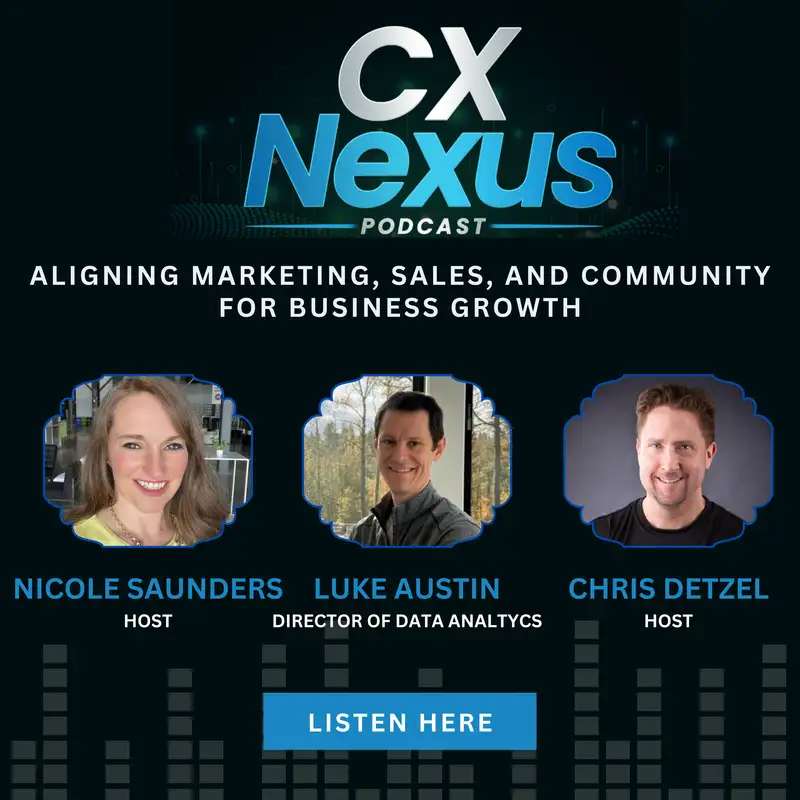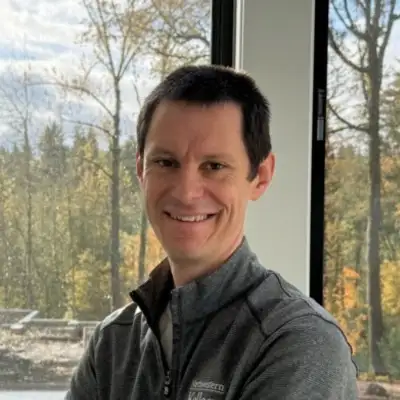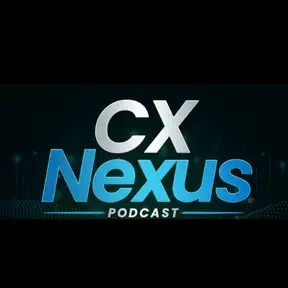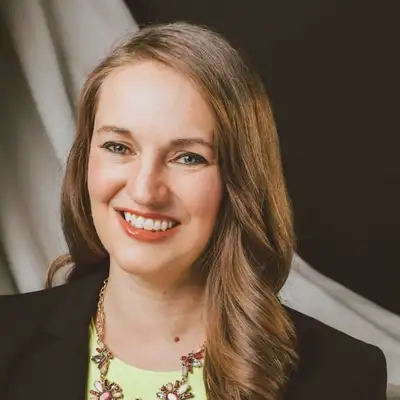
Aligning Marketing, Sales, and Community for Business Growth
Nicole Saunders: Welcome to CX Nexus, the podcast where we explore intersections between community and all aspects of customer experience. My name is Nicole Saunders, and I'm here with my co host
Chris Detzel: Chris Detzel.
Nicole Saunders: Hey, Chris, how are you doing today?
Chris Detzel: Hey, I'm pretty good. Nicole, how are you?
Nicole Saunders: I'm good. I'm excited. We have our guest today is Luke Austin, director of analytics and insights at Reltio.
Nicole Saunders: Luke, how are you?
Luke Austin: Doing good. Enjoying some sunny weather up here in the Pacific Northwest.
Nicole Saunders: Oh, that's nice.
Chris Detzel: Yeah, it's it's nice and warm here in Dallas. And how about you, Nicole, you guys get cold weather where you're at sometimes.
Nicole Saunders: We do, but we're getting some springtime. It's going to be almost 70 here in Wisconsin today.
Nicole Saunders: We've got some blue skies. So spring is finally starting to come. That's great.
Chris Detzel: Yeah. So Luke, you and I know each other, obviously we've worked together for, what's funny is for two and a half, three years, however long you've been with RealTO. And then we even worked together. A lot less, but we still worked at the same [00:01:00] company at Imperva.
Chris Detzel: I don't know if you remember those days, but no but tell us a little bit about yourself, your role, what you do and all those kinds of things. And we'll get started.
Luke Austin: Yep. Like you said, a director and analytics and insights at RelTO I sit in marketing but I, uh, a shared resource across our go to market functions.
Luke Austin: So marketing, sales customer success to some extent. And my role is spread across a couple of different areas. One, obviously, given that I sit in marketing, one of the things I focus on is helping us understand where our marketing investments are yielding returns for us, the kinds of activities that are generating, outcomes in terms of pipeline creation.
Luke Austin: And other KPIs that we care about marketing but also I I'm, I play a large role in just our pipeline inspection at RealtyOwns. So understanding, what the current state of our pipeline is, historical trends in our pipeline, how we can use that to project what we expect to happen in, out quarters.
Luke Austin: So not necessarily in the current quarter, but next quarter, two quarters out and then and then. Also, translating that [00:02:00] into to targets for the company. When you go through annual front planning process, both understanding what we've got in pipeline, where we expect to materialize out of in terms of bookings to help set.
Luke Austin: At bookings expectation, but then once we've. Once the, our leadership and the board is settled on, our bookings targets, then translating those back into what we need to do in terms of, creating pipeline for existing customers and potential prospect customers and then other KPIs that ladder up to that.
Luke Austin: So we've got the full suite of, leading indicators through, by creation, the support of booking targets.
Chris Detzel: Yeah. The one thing I love about. What you do look at, and this is what I always say to people is you need a guy named Luke Austin or somebody like Luke, to, I'm serious, as data driven as our company is, but and, if you need somebody like you to really provide, one, the guidance and, the skills that you have and those things.
Chris Detzel: So can you talk a little bit about like how you work with different [00:03:00] parts of the organization? I could say, yeah, I'll do best.
Luke Austin: Yeah. So I work. Obviously I, I spent a lot of time working in the marketing team with folks in the marketing team. But I also spend a lot of time working with our partners in sales and in finance.
Luke Austin: And, um, Amy Dodge who is the, who sits on T staff and is, our VP of business operations. She doesn't have a, a team herself, but she, many of us across the organization. Our kind of borrowed resources for her. Yeah. So I spent a lot of time working with her.
Luke Austin: And yeah, it's pretty, pretty good mix of folks.
Nicole Saunders: So Luke, as part of the goal of our podcast here is to help educate people on how different parts of the business work. Not everybody may be familiar with the terminology pipeline and bookings. Can you give us like the one on one primer?
Nicole Saunders: If somebody's never heard those terms that they've heard them, they're not sure what they mean. How would you explain it?
Luke Austin: So pipeline is just a dollar value [00:04:00] representation of. The opportunities that sales is working on. Most, in particularly in B2B tech there's typically a process through which, interactions with people at companies that we might be interested in doing business with get turned into something a sales guy is assigned to and is pursuing and trying to turn into business for us.
Luke Austin: So once, once you clear the hurdles of, Identifying that. Yep, there's a potential business opportunity here. We're talking to somebody who's got budget. There's this common acronym bands. It's used for qualifying pipeline budget authority, need and time frame.
Luke Austin: So there's a kind of standard industry indicators. Once you're talking to somebody who has those things or represents, the ability to. make decisions across those four dimensions. Typically there's this handoff process in which you, a salesperson and account, in our case, an accounting executive would take that opportunity and they'll say, okay, I'm, this, there's a potentially valid deal here.
Luke Austin: And so once that [00:05:00] happens, it's now a sales opportunity and it's considered pipeline. So it's it represents, there's been some level of qualification of this, potential potential sale. And there is engagement with somebody at the customer side who is, has the authority and the budget, there's demonstrated need for your product.
Luke Austin: And so there's, there's potential sale there. So once, once an opportunity, once, once something gets into the pipeline, there's a whole, most companies have a whole set of stages. The sales guys will take it through from, early stage, just, just. Had some early conversations established.
Luke Austin: There's something potentially here to, yeah, we're in the final stages of, you know, proof of concept or we're in, contractual discussions. And that spectrum is, represents there's a whole, uh, you can use those stages as a means of rejecting what you think you'll.
Luke Austin: Materializes in terms of sales or booking. So we can't the other question I was around bookings. So bookings is when you actually, have commitment from [00:06:00] the customer that, the deal has been closed and they're, they're they're paying you a certain amount for. For or, whatever the sale is.
Luke Austin: So anyway, so yeah, you can use those different stages to project where, what you think you're going to see in terms of the bookings and really when you'll see it. So if we've got a certain dollar amount in our first stage, we can expect that 15 percent of that'll turn into bookings for us the next year.
Luke Austin: And so we can use these kinds of stages to tell what's coming.
Nicole Saunders: So it, it sounds like this is the process by which the business can predict. Do we have. enough sales deals in the works to hit our revenue targets for this year. We know, Hey, we've got X amount in pipeline. We know that about 15 percent of that will typically convert, can convert.
Nicole Saunders: So sorry, I was at a conference last week. So my, my talking muscles are tired. But so you've got that, so you can figure out those numbers. And I imagine that helps figure out like, Hey, is the sales team getting enough prospects? Is marketing generating enough potential [00:07:00] leads? That whole machine that goes around generating business.
Nicole Saunders: These are the numbers that you're looking at to figure out are we on track? Are we doing enough? Do we need to come up with something, a new hot product? Do we need to do a different marketing campaign? All that kind of thing to play with those pieces.
Luke Austin: Very much. So the sales pipeline is what we can use to tell what we think is going to happen in terms of booking.
Luke Austin: So it's that's the first point at which there are dollars affiliate and if somebody has looked at it and said, okay, there's probably this amount of dollars associated with these potential deals.
Nicole Saunders: So yeah, let's talk a little bit about that sort of what I often refer to as, or here referred to as the top of the funnel, right? This is how you're bringing in those initial prospects so you have a pipeline. What are some of the teams that you work with and that have a role to play in getting those leads in there in the first place?
Luke Austin: So top of the funnel is an interesting term in and of itself, because the more time you spend talking [00:08:00] with marketing and sales, in other parts of the business, the terms don't always mean the same thing. So from a sales perspective, top of the funnel typically means that's.
Luke Austin: That's the, when they use the word top of the funnel, they're typically referring to like early stage pipeline. And from marketers perspective, that's like way bottom of the funnel. They're, most marketing teams are like, Oh, we're trying to, the end point is getting it to pipeline.
Luke Austin: Once we've done that, we've done our job and now it's in sales hands. I'm
Nicole Saunders: hearing there's funnels within funnels.
Luke Austin: Yeah, exactly. Cause there's the sales funnel which starts at early in the first stage of pipeline, it goes through bookings and there's a marketing funnel, which exists entirely before that.
Nicole Saunders: Right.
Luke Austin: One, one thing that's important when you're talking, among these different functions is to align on that vocabulary or if not make sure that you're using it in the same way that they understand it.
But yeah, so your question about top of the funnel in this case sounds like it's more about the pre pipeline activities that, marketing team might execute to.
Luke Austin: Engage with people at prospect accounts. [00:09:00] And so I'm using my terminology very carefully because at Realty, we've gone through this transition in the last year from a lead to opportunity process where we, we're focused on generating leads or basically getting names in our database and trying to convert those individuals and opportunities which.
Luke Austin: Pretty standard process. But the, for products like ours that are, million dollar purchases and there are, a dozen people involved in the decision making process, putting all your eggs in one person's basket early in the, in the sales evaluation process is, it's risky.
Luke Austin: Somebody came to our website and downloaded the Gartner. Market guide and we point a BDR at them and call them. And, we put all our eggs and getting through to this guy and converting him into an opportunity. If he, if he gets busy or he's doing something else, or, that, that dies early on, we lose contact.
Luke Austin: And so we've shifted to this model where we're looking at, rather than thinking of accumulating leads, we're trying to engage with. [00:10:00] Companies and individuals, this company. And so in our case, the universe of potential companies we can sell to is probably 6, 000 companies. We sell to big companies and there aren't, there's a finite number of them in the world.
Luke Austin: And so we can pre populate our, our view of the market and our systems like Salesforce, we can put a company in there for every one of these companies we can sell to. And now we're just trying to light up the dashboard on these companies. That same guy downloads Gardner Magic Quadrant.
Luke Austin: And somebody else attends a webinar and somebody else, we talked to an event and suddenly there are three different data points. And so that's, that's really interesting for us. We want to prioritize that account and get a BDR trying to talk to those three people and get those into sales.
Luke Austin: So by the time sales receives it, they've got the beginnings of a team of people on a buying team that they can, that they can pursue. So that was a long segue. It wasn't the question you asked, but I wanted to. No
Nicole Saunders: worries.
Luke Austin: To take a second to talk about, how we're thinking about that top of funnel activity right now.
Nicole Saunders: And I imagine this is different at [00:11:00] every organization, right? So anybody that's listening should probably go figure out how your company uses this terminology, because each organization may have a different process, may have slightly different terminology, may mean slightly different things.
Chris Detzel: And the way we the way we describe that as ABX.
Chris Detzel: So account based experience, I'm not off there Luke? That's really what that process is about is the ABX. So three people from one account. Doing something on your website or going to an event or whatever it is doing those things. And there is a term for it and it's a very and it's working for us really well.
Chris Detzel: So go ahead, Luke, sorry.
Luke Austin: No, that's absolutely right. The idea was, excuse me the sales team and their sales process is selling to an account. They're selling to, they're identifying multiple people at the account. That's the, this is, that's just how they sell. But in marketing, it's all about getting that lead and, converting that lead into an opportunity.
Luke Austin: And so the idea is let's shift the way we think about marketing and market to accounts and see if we can, [00:12:00] fill, see if we can find the accounts where the, that we're getting multiple engagements. And send those to, pass those along to our sales team. So as opposed to having all of the
focus be on, Oh, this one person did this one thing, maybe we get multiple signals of lower level
engagement across an account and that's a better indicator that there's a potential opportunity there.
Nicole Saunders: So Luke, what is one thing about the work that you do that you wish more people in your organization knew?
Luke Austin: It's a good question. I think one, just from my, from my, um, where I ended up spending my time, I think, and anything, I think there's probably decent appreciation of this, but I, when I, in the forums where I'm sharing information, most of what people see are slides and, visualizations and stuff and the tableau is the, the lens through which a lot of what I do is seen but most of [00:13:00] my time doesn't go into developing visualizations and dashboards.
Luke Austin: Most of my time is spent on, Data preparation, so sourcing data from different systems, doing all the ETL and transformation, constructing the KPIs, finding automated ways to keep tabs on all these, different areas of the business that we feel are important. And so there's, there's always a tension between.
Luke Austin: Additional things people want to see and ad hoc asks, and how can you build this? And can can you do that? And there's finite resources because it's just me. And so there's, making sure that I'm aligned with my leadership on, what the key priorities are is extremely important because I think, sometimes there's a perception that it's easy to just be an on demand reporting resource for anybody who wants, whatever thing popped up today.
Luke Austin: That's important to them today. And it's not necessarily the case. Especially given the breadth of things that we need to keep tabs on. We have to pay careful attention to. [00:14:00] Investing time and resources where we can 1 that are areas that are going to drive business outcomes and 2 that we can scale because I'm just 1 person.
Luke Austin: Welcome
Chris Detzel: to my world. Yeah. Preaching to the
Luke Austin: choir, I'm sure.
Chris Detzel: And Nicole's done such a good job at Zynta. She has a few people on her team, over the last seven years. Couple questions. I want to shift this to community like stuff. And one of the things that, I've tried to do a lot of is think about business outcomes for our community.
Chris Detzel: And Luke, as I've worked with you over the last, I guess it's been what, two years specifically, you and I hands on doing some stuff together. Can you talk a little bit about. What you're seeing within community engagement shows those, webinars or whatever, specifically, and I just want to get, I'm trying not to lead you too much here because I want to get your view of outcomes that, you've seen and might've, that might've [00:15:00] surprised you or not, I don't know.
Chris Detzel: Cause it's really the first time you've done, you've really worked with somebody like me, in the past.
Luke Austin: Now, so go ahead.
Chris Detzel: Yeah,
Luke Austin: so I, so yes I there are several things that have surprised me. So first off, as a consequence of us transitioning to this account based view, where we're pulling together all the stuff that happens in the account rather than, trying to find the person who filled out the form and pass them to a BDR.
Luke Austin: There are, things that start to, Appear in a way that, we wouldn't have seen before. So the community shows are actually, an amazing example of that. So we've applied this same account based view to not just prospect accounts, but existing customer accounts with the intention of identifying where
there are potential upsell and cross sell opportunities.
Luke Austin: So selling more to customers that, that are already customers. And. Understanding who is engaging with us at these customer accounts and what they're, what they're doing [00:16:00] is important to that. And accounts that are engaging with us more consuming more of our content and, in ways that we may not have been aware of.
Luke Austin: Is important, in the old world, most of, most of what we would have been aware of collectively as an organization from customer would have been a direct interaction with the salesperson and those are important. Those relations are important, but there's a whole lot of stuff that's going on that, and it was flying under the radar before.
Luke Austin: And so the community shows are an excellent example of that. One of the things that we've started paying a lot of attention to this fiscal year, which, we're gonna start it in February as a. Big priority for our business is driving expansion bookings. So again, selling more to our existing customer base.
Luke Austin: And as part of that, one of the things we're starting to surface is where customers are engaging with us. And last week we were looking at quarter to date engagements and, our community shows were like, 50 percent of all customer engagements were from these community shows that Chris has been churning out.
Luke Austin: Weekly [00:17:00] almost. And they're on a variety of topics about our product. It's, super focused on on things that are of interest to our customers relative to Realteo. And so it's, it's a great source of information about which accounts are. Engaging with us and what they're consuming.
Luke Austin: And it's the community shows in particular have been huge drivers of an increase in engagement this quarter. 1st of all they've been the primary driver of engagement going into last year. But especially this quarter, we see a huge uptick engagement and. We're looking at engagement across a number of different channels.
Luke Austin: So the community shows are one the community platform, higher logic. Also like our paid search and, engagement staff on our website, interactions with our sales guys, and just, the volume of engagements from community shows has just been eyeopening. And the other thing that we look at is a correlation between engagements between these different channels and the eventual creation of pipeline with these accounts.
Luke Austin: So essentially what we're, we're trying to understand is there a relationship between engagement. [00:18:00] And the appearance of pipeline because, we don't always have a definitive link between the 2, but if we can correlate them, it's, it's a good indicator. And so we're seeing a lot of pipeline materialize at these accounts where we're seeing high engagement.
Luke Austin: And the community shows, so so, yeah. Definitely. Yeah. And I'll be, I
Chris Detzel: appreciate that insight. Because I think that's important as community leaders for us to think about the true business outcomes of what we're doing, we've got to try to connect, Whether it's pipeline, whether it's retention, whether it's product adoption, whatever that is, I think that's important.
Chris Detzel: And I know Nicole hears me talk about this all the time. As a matter of fact, she's probably
Chris, we're talking about this again, but I
Nicole Saunders: don't think, I don't think you can over emphasize the importance of. Measuring community impact because at the end of the day, every community team has to show that they've got an impact on the business and it's got to be something beyond the engagement of posts and likes and page views.
Nicole Saunders: It's got to be the kinds [00:19:00] of things that you're talking about, Luke it's, how is that actually playing into the decision making about. Lifetime expansion and sales and all of those kinds of things.
Luke Austin: And I think when you get into a forum where you can show a dollar impact on pipeline from community interactions against, more traditional forms of engagement, digital and digital advertising stuff on the website, and you can show that from a dollars a pipeline perspective.
Luke Austin: The community is having a big impact like that's. That's a powerful it's it allows you to communicate to stakeholders across the business and different functions in a way that they can understand because it's dollars now.
Nicole Saunders: Exactly.
Chris Detzel: Anytime you can translate dollars to whatever you're doing, you're on the right track,
Nicole Saunders: that's job security right there.
Chris Detzel: Maybe one thing that I would say is. And we haven't touched upon this because we really haven't looked at so when our members log in, when they post, when they like, when they reply, we are [00:20:00] looking at that information. We're not prioritizing those particular engagements for anything yet. But when whenever people are looking at the dashboard, like BDRs or others, they know That one of the actions that particular customer took or even prospect that they logged in the community or that they replied or liked or whatever, right?
Chris Detzel: It's not just those community shows or webinars, live webinars that we're tracking. I want to try, future looking for me and, I want to see and think about kind of the prioritization of those particular engagements and whether or not they mean some, I don't know. Like I'm not.
Chris Detzel: Clear on that. And I think that's, we got that in there and that was my first kind of thinking around that look, but, we'll see, I'll be interested to see if that pans out in any way, it's a test.
Luke Austin: Yeah. So what Chris is alluding to is we built. As part of this, transformation to looking at accounts, we built this tool for our [00:21:00] AEs and our BDRs that allows them to look at all of their accounts prioritized by base, based on where they are or where we believe they are in a sales cycle, looking at, their.
Luke Austin: History of engagements and so forth. And one of the things we've done is we've taken all the data from higher logic, which is the community platform and pulled it in and mixed it together with, all of our other data about interactions. And so that our AEs and BDRs can see when they look at, Wells Fargo, here are the 13 people at Wells Fargo who have, engaged with us.
Luke Austin: And here's the, 50 individual things those 13 people did. And so in that forum, now the BDR communities can say, Oh, man, this, Joe at Wells Fargo has been all over our community. Maybe we should talk to that guy. Exactly.
Chris Detzel: Any other questions, Nicole?
Nicole Saunders: So I'm curious, we've talked about, you're seeing the value of those community interactions, you're measuring it, you're starting to put a dollar value to it.
Nicole Saunders: Have you started to see some trends? Are you seeing impacts where your [00:22:00] accounts that engage in the community are spending a little bit more with the company than others, or is it too early to tell?
Luke Austin: It's a good question. We are seeing an increase in expansion pipeline overall. And we're seeing an increase in pipeline we attribute to the, engagements in the community show, community shows.
Luke Austin: You could make a case that there's a positive relationship there where we're seeing more engagement in the communities and we're seeing in the community and we're seeing an increase in pipeline. Think there's, there's some evidence, some early evidence that's the case, but we haven't, gone through and done an analysis of do on average, do we see more business with companies that are more engaged and, in the community?
Luke Austin: That's probably a pretty strong hypothesis that we might. Okay.
Chris Detzel: Yeah, I think so as well. And, to be fair, some opportunities for us is we're not looking at every single engagement across the entire organization. At the moment, there's a big opportunity for us to do some things like, training.
Chris Detzel: Maybe we can [00:23:00] incorporate, is our customers taking training courses? They are we attributing that to the model? Are they, or CSMs? Yes. They're in Gainsight. Are they talking to and doing these, QBRs with their customers? And maybe that's an attribution that we should add to the engagement piece or whatever, right?
Chris Detzel: Like some of that, we still, I think we should think about, I'm not sure it's hard to do some of that. We do have other projects going on that might. Allow us to do more of that in the future. More to come on that. I don't know if that's fair to say. Yeah, exactly. Anything we missed that you can think of that, you would want people to know what you do and all that kind of stuff.
Luke Austin: No, I think, especially as it relates to community and community folks, I think that's probably a good, good intersection of, where the measurement comes into play for, the work that you've been doing and how we're showcasing it [00:24:00] and among the portfolio of other activities that are done and where it's starting to shine.
Chris Detzel: Great. Thanks, Luke. I appreciate that.
Nicole Saunders: Yeah. Thank you for joining us, Luke. And for the community professionals listening out there, go make friends with your marketing intelligence team. Make sure that you you're hanging out with the Luke's at your company and getting to know them because there's so much great information you can get once you start connecting those dots.
Chris Detzel: It's really crazy. Absolutely. All right. Thank you everyone for, go ahead and Nicole, I'm going to let you shut us down here.
Creators and Guests



